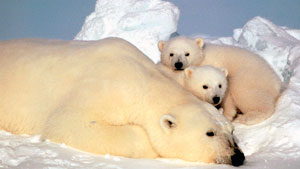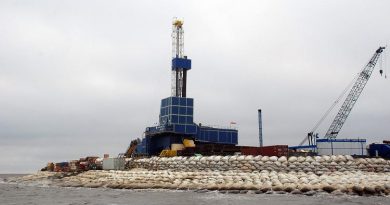New study sheds light on polar bear origins
 The iconic white bears that prowl the sea ice north of Alaska and across the Arctic may have evolved into a separate species more than 600,000 years ago, diverging from their closest bruin relatives about five times earlier than indicated by recent studies.
The iconic white bears that prowl the sea ice north of Alaska and across the Arctic may have evolved into a separate species more than 600,000 years ago, diverging from their closest bruin relatives about five times earlier than indicated by recent studies.
Although all modern polar bears likely share the ancestry of female brown bears — possibly due to interbreeding with a single Irish sow during the height of the ice age — a detailed analysis of the DNA carried by these highly intelligent, seal-eating carnivores revealed surprisingly little genetic overlap with their grizzly cousins to the south.
“Our results thus provide a fundamentally different picture of the polar bear’s evolutionary history, compared with the ‘recent-origin’ scenario’ ” suggested by the DNA passed down solely through mothers, reported an international team of scientists in a new study published this week in Science.
“Polar bears are a … genetically differentiated species, rather than a lineage that evolved recently from a brown bear genotype,” according to the report.
This earlier emergence of the polar bear as an ice-dependant marine mammal distinct from terrestrial brown bears raises troubling questions about its survival in the face of shrinking Arctic ice during summer and other threats triggered by people.
“An evolutionary origin several hundred thousand years ago implies that polar bears as a species have experienced multiple glacial cycles and have had considerable time to adapt to Arctic conditions,” wrote evolutionary biologist Frank Hailer and seven co-authors from Germany, Sweden, Spain and Oregon.
“However, the low genetic diversity in polar bears suggests that changes in the environment, such as warm phases, caused population bottlenecks.”
Modern problems
Although polar bears may have survived several cycles of expansion and retreat of continental ice sheets during the past 600,000 years, the authors warned that the species now faces unique modern problems that complicate its prospects — loss of habitat, conflict with people, and accumulation of industrial chemicals in the food chain that threaten bear health.
These “multiple human-related stressors … could magnify the impact of the current climate change, posing a novel and likely profound threat to polar bear survival,” they wrote.
That worries former Alaska-based field biologist Steven Amstrup, one of the world’s leading polar bear researchers. Evidence suggests that the last couple of interglacial periods weren’t as warm as what’s expected for the Arctic toward the end of the 21st century, said Amstrup, who now works with the conservation group Polar Bears International.
“If we continue on our current greenhouse-warming path, it will be far warmer in 50 years than at anytime in the existence of polar bears,” he said in an email to Alaska Dispatch. “By the latter half of this century, polar bears will be off the charts of anything they have experienced during their evolutionary history. … Ultimately, a continually warming world will have no sea-ice habitat for polar bears, and that is the rub they face.”
Origins of great white bears
Compared to other bears, not much has been known about the origins of polar bears until recently. Ultimately, scientists believed, they shared ancestry with brown and black bears. Yet figuring out the details of polar bear evolution and natural history has never been more urgent, given the impact of accelerating climate change on their habitat.
Shrinkage of sea ice during summer is just one problem. Rising air temperatures, thawing permafrost, rising sea levels, vegetation shifts, and increasing rainfall also have the potential to devastate animals adapted to hunting, mating, raising offspring, and denning in a frozen world.
When ice habitat shrinks or disappears, polar bears must travel farther. They sometimes swim long distances to reach ice platforms. They must work harder to find food and denning sites. With ice melting sooner and forming later, the bears are forced to spend more time on land, where they compete — and sometimes interbreed — with brown bears.
The fear that U.S.-managed populations could eventually go extinct due to ice loss led the United States to list the bears as threatened and designate 187,000 square miles of North Slope and Arctic Ocean as habitat critical to their survival. The designation is now embroiled in court challenges.
A new federal plan for managing the recovery was released for comment this week — and immediately came under fire because it exempts greenhouses gas emissions from being regulated as a factor in bear survival.
Changing habitat
The environmental study by the U.S. Fish and Wildlife Service acknowledged that rising emissions of greenhouse gases contribute to the ice loss that directly threatens the existence of polar bears, but concluded that trying to regulate these emissions under the endangered species act would embroil the agency in a legal morass that would sabotage its efforts.
“Defending against such suits will divert available staff and funding away from productive polar bear conservation efforts,” the study said.
The new paper about polar bear genetics — “Nuclear Genomic Sequences Reveal that Polar Bears Are an Old and Distinct Bear Lineage” — was published in Science four days later. It analyzed the genetic material from 49 individual animals, including 19 polar bears and 18 brown bears. Scientists then compared the results to studies of the mitochondrial DNA from bears.
“Previous studies (here and here) of polar bears focused mainly on mitochondrial or mtDNA, which is passed on from mother to offspring and only comprises a very small portion of the entire genome,” the authors explained in a release posted by Science. “Because each part of the genome can tell its own story, using solely mtDNA to reconstruct a species’ evolutionary history is like reading only a few pages of a book — scientists are prone to miss large chunks of information. In this study, Frank Hailer and colleagues set out to test whether the nuclear genome told the same story as mtDNA, which indicated that polar bears are essentially a recently evolved type of northern brown bear.”
Expanding the genetic horizon
Biologist Beth Shapiro is an expert in ancient genetics and one of the lead authors of the 2011 study that found Irish brown bear ancestry in modern polar bears. She called the new study “a really interesting finding” that substantially expands the genetic horizon on polar bear natural history.
She and her team expected that nuclear DNA analysis would find a more distant origin for polar bears than a more limited mitochondrial DNA analysis, but the nuclear version is much more difficult to pull off.
“Unfortunately, old bones do not preserve nuclear DNA particularly well and we still are restricted to the smaller data set of the much more common (mitochondrial DNA),” she said in an email to Alaska Dispatch. “It is very exciting to finally see some real data being applied to the question.”
The new findings also “underscore our main finding a year ago — that there must have been hybridization between the two lineages in their recent history,” she said.
Still, the broad genetic conclusion of the study — that polar bears diverged from brown bears between 338,000 and 934,000 years ago — won’t close the debate about the origin of the species, Amstrup predicted.
Divergence
Previous best guesses on polar bear divergence have ranged from tens of thousands to as many as 1 million years ago, including one hypothesis that Amstrup helped formulate in 1990 that put the break at 250,000 years ago.
“Polar bears are very poorly represented in the fossil record, so what we know about their evolution is largely dependent on modern molecular genetics,” Amstrup said. “And as that science advances, we keep discovering new things. I believe it may be some time before geneticists settle on a time of separation on which they all can agree.”
Another intriguing finding: polar bears and brown bears appear to have gone their separate ways just about the time the climate plunged to a cooling period, the authors reported. Coincidence? The authors say they think that this episode of “drastic cooling” may be what finally triggered the genesis of the polar bear.
“This study suggests that past adaptation to a changing climate may have been a slow process,” Hailer and his co-authors said in a release from Science. “Consequently, polar bears may not have enough time to adjust to these warmer conditions as they have in the past.”
Contact Doug O’Harra at doug(at)alaskadispatch.com
For more stories from Alaska Dispatch, click here.



